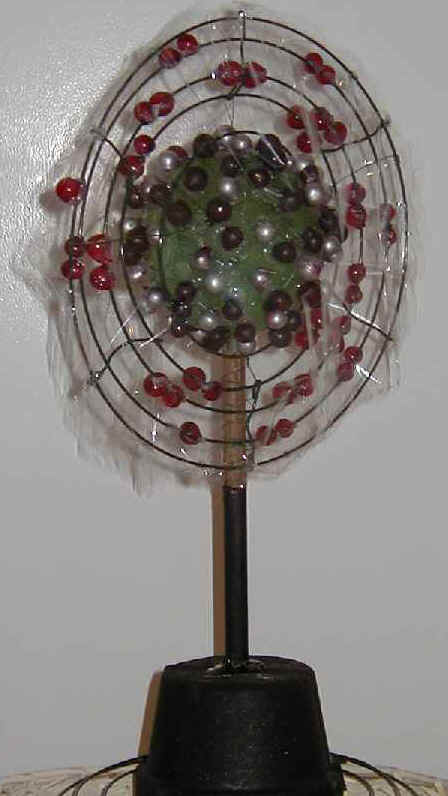|
I'd like to this |
Filament In Electric Heaters
History
(Gr.
molybdos, lead) Before Scheele recognized molybdenite as a distinct ore of a new
element in 1778, it was confused with graphite and lead ore. The metal was
prepared as an impure form in 1782 by Hjelm. Molybdenum does not occur native,
but is obtained principally from molybdenite. Wulfenite, and Powellite are also
minor commercial ores.
Molybdenum
is also recovered as a by-product of copper and tungsten mining operations. The
metal is prepared from the powder made by the hydrogen reduction of purified
molybdic trioxide or ammonium molybdate.
The
metal is silvery white, very hard, but is softer and more ductile than tungsten.
It has a high elastic modulus, and only tungsten and tantalum, of the more
readily available metals, have higher melting points. It is a valuable alloying
agent, as it contributes to the hardenability and toughness of quenched and
tempered steels. It also improves the strength of steel at high temperatures.
It
is used in certain nickel-based alloys, such as the "Hastelloys(R)"
which are heat-resistant and corrosion-resistant to chemical solutions.
Molybdenum oxidizes at elevated temperatures. The metal has found recent
application as electrodes for electrically heated glass furnaces and foreheaths.
The metal is also used in nuclear energy applications and for missile and
aircraft parts. Molybdenum is valuable as a catalyst in the refining of
petroleum. It has found applications as a filament material in electronic and
electrical applications. Molybdenum is an essential trace element in plant
nutrition. Some lands are barren for lack of this element in the soil.
Molybdenum sulfide is useful as a lubricant, especially at high temperatures
where oils would decompose. Almost all ultra-high strength steels with minimum
yield points up to 300,000 psi(lb/in.2)
contain molybdenum in amounts from 0.25 to 8%.
|
Atomic Number: |
42 |
|
Atomic Symbol: |
Mo |
|
Atomic Weight: |
95.94 |
|
Electron Configuration: |
[Kr]5s14d5 |
Periodic Table
of the Elements
A Resource for Elementary, Middle School, and High
School Students
Click an element for more information:
|
Period |
Group** |
|
|
|
|
|
|
|
|
|
|
|
|
|
|
|
|
|
|
1 |
|
18 |
||||||||||||||||
|
1 |
1 |
2 |
|
|
|
|
|
|
|
|
|
|
13 |
14 |
15 |
16 |
17 |
2 |
|
2 |
3 |
4 |
|
|
|
|
|
|
|
|
|
|
5 |
6 |
7 |
8 |
9 |
10 |
|
3 |
11 |
12 |
3 |
4 |
5 |
6 |
7 |
8 |
9 |
10 |
11 |
12 |
13 |
14 |
15 |
16 |
17 |
18 |
|
-------
VIII ------- |
||||||||||||||||||
|
4 |
19 |
20 |
21 |
22 |
23 |
24 |
25 |
26 |
27 |
28 |
29 |
30 |
31 |
32 |
33 |
34 |
35 |
36 |
|
5 |
37 |
38 |
39 |
40 |
41 |
43 |
44 |
45 |
46 |
47 |
48 |
49 |
50 |
51 |
52 |
53 |
54 |
|
|
6 |
55 |
56 |
57 |
72 |
73 |
74 |
75 |
76 |
77 |
78 |
79 |
80 |
81 |
82 |
83 |
84 |
85 |
86 |
|
7 |
87 |
88 |
89 |
104 |
105 |
106 |
107 |
108 |
109 |
110 |
111 |
112 |
|
114 |
|
116 |
|
118 |
|
|
|
|
|
|
|
|
|
|
|
|
|
|
|
|
|
|
|
|
|
Lanthanide
Series* |
58 |
59 |
60 |
61 |
62 |
63 |
64 |
65 |
66 |
67 |
68 |
69 |
70 |
71 |
|
|
||
|
Actinide
Series~ |
90 |
91 |
92 |
93 |
94 |
95 |
96 |
97 |
98 |
99 |
100 |
101 |
102 |
103 |
|
|
||
For a list of a the element names and symbols in alphabetical order,
click here
What
is the Periodic Table?
How to use the Periodic Table
Click
here to see Mendeleev's original Periodic Table
Chemistry in a Nutshell
Naming New Elements
[ LANL
| DOE | Disclaimer
]

